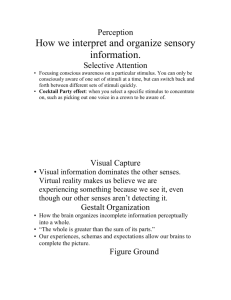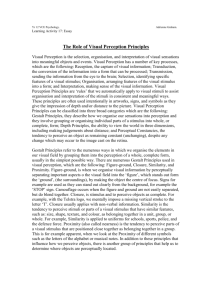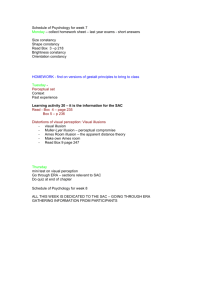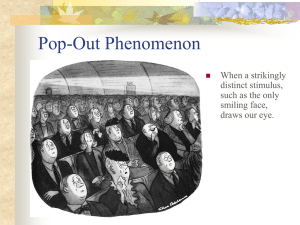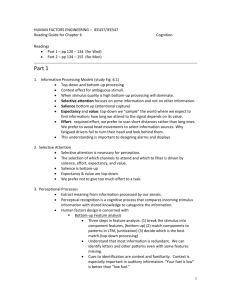Unit 4 PowerPoint Myers for AP, Unit 4
advertisement
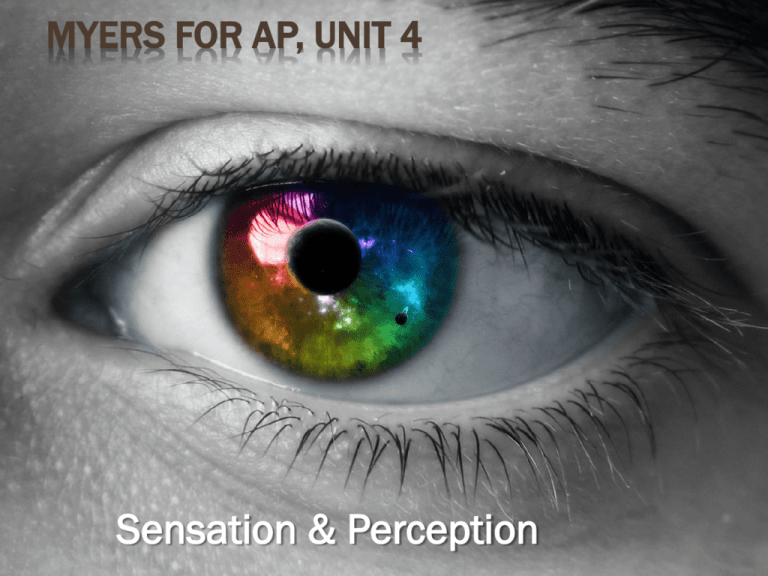
MYERS FOR AP, UNIT 4 Sensation & Perception DO NOW Which of your senses do you think would be the hardest to live without? Why? AP OBJECTIVES Discuss basic principles of sensory transduction, including absolute threshold, difference threshold, signal detection, and sensory adaptation. Discuss the role of attention in behavior Explain the role of top-down processing in producing vulnerability to illusion. KEY TERMS & MORE KEY TERMS Sensation, p. 116 Perception, p. 116 Bottom-up processing, p. 116 Top-down processing, p. 116 Selective attention, p. 117 Inattentional blindness, p. 118 Change blindness, p. 119 Psychophysics, p. 120 Absolute threshold, p. 120 Signal detection theory, p. 121 Subliminal, p. 121 Priming, p. 121 Difference threshold, p. 122 Weber’s law, p. 123 Sensory adaptation, p. 123 Transduction, p. 124 Wavelength, p. 125 Hue, p. 125 Intensity, p. 125 Pupil, p. 126 Iris, p. 126 Lens, p. 126 Retina, p. 126 Accommodation, p. 126 Rods, p. 126 Cones, p. 126 Optic nerve, p. 126 Blind spot, p. 127 Fovea, p. 127 Feature detectors, p. 129 Parallel processing, p. 130 Young-Helmholtz trichromatic (three-color) theory, p. 132 Opponent-process theory, p. 133 Audition, p. 134 Frequency, p. 134 Pitch, p. 134 Middle ear, p. 135 Cochlea, p. 135 Inner ear, p. 135 Place theory, p. 137 Frequency theory, p. 137 Conduction hearing loss, p. 138 Sensorineural hearing loss, p. 138 Cochlear implant, p. 138 Kinesthesis, p. 142 Vestibular sense, p. 142 Gate-control theory, p. 143 Sensory interaction, p. 147 Gestalt, p. 151 Figure-ground, p. 151 Grouping, p. 152 Depth perception, p. 153 Visual cliff, p. 153 Binocular cues, p. 153 Retinal disparity, p. 153 Monocular cues, p. 154 Phi phenomenon, p. 156 Perceptual constancy, p. 156 Color constancy, p. 158 Perceptual adaptation, p. 160 Perceptual set, p. 161 Extrasensory perception (ESP), p. 166 Parapsychology, p. 166 KEY PEOPLE Richard Axel Georg von Bekesy Linda Buck Gustav Fechner Eleanor Gibson Ewald Hering David Hubel Harry McGurk Ronald Melzack James Randi (again) Herman von Helmholtz Richard Walk Patrick Wall Ernst Weber Torsten Wiesel Thomas Young TOP-DOWN PROCESSING Bottom-up processing Begins with sensory receptors and heads for the brain. We process this way when we don’t know something; we start at the bottom and work our way up. Top-down processing Information that a person brings to the situation that influences both perception and recognition We process this way when we already know things. We start at the top and integrate information An example: Stereotyping uses previous expectations to make judgments DISCUSSION But wait! Stereotyping is bad, right? Why is top-down processing so important? What are some of the pros and cons of selective attention? How is selective attention related to the evolutionary perspective? Give examples of when you were so caught up in doing something that you missed something you should have attended to, or when the environment was so distracting that you couldn’t focus. SAY WHAT??? Aoccdrnig to rscheearch at Cmabrigde Uinervtisy, it deosn’t mttaer in waht oredr the ltteers in a wrod are, the olny iprmoetnt tihng is taht the frist and lsat ltteer be at the rghit pclae. The rset can be a total mses and you can sitll raed it wouthit a porbelm. Tihs is bcuseae the huamn mnid deos not raed ervey lteter by istlef, but the wrod as a wlohe. DO NOW: HOW SENSITIVE ARE YOU? Complete the handout! Highly sensitive persons: Are more aware of all the possibilities in a situation. Naturally process information from the environment more carefully and study it thoroughly before acting. Are more aware of subtleties in their surroundings Are often intellectually gifted, unusually creative and productive workers, and attentive and thoughtful in close relationships. Are more easily overwhelmed when in a highly stimulating environment. Become exhausted when bombarded by multiple stimuli and need more down time to recover. Source: Aron, E. N. (1999). The highly sensitive person: How to thrive when the world overwhelms you. New York: Random House. SELECTIVE ATTENTION EXPERIMENT! Human Earphones We need four volunteers! And two textbooks Dichotic listening INATTENTIONAL AND CHANGE BLINDNESS Umbrella video – inattentional blindness How could this get us in trouble in real life? Change Blindness videos: FIELD-DEPENDENT OR INDEPENDENT? How fast can you find the 12 items? Herman Witkin devised the Embedded Figures Test (EFT) to measure field dependence–independence and has studied this for more than 30 years) •Field Dependent: Difficulty locating hidden figures within complex surroundings (prefer social sciences and education) •Field Independent: Easily locating hidden figures (tend to favor natural sciences, math and engineering) •Scores on field dependence– independence are relatively stable over time. IMPORTANT DETAILS (NIB) Gustav Fechner developed three methods of experimental measurement used to study sensory phenomena: Method of limits (minimal stimulus gradually increasing = JND) Method of right and wrong: Present either single stimuli at the threshold or pairs of stimuli that are very similar, and the participant responds “yes” or “no” if they perceive a difference or not. Method of adjustment: Adjust a comparison stimulus until identical to the standard stimulus SIGNAL DETECTION So WHAT? Who cares? Why does this matter, especially since absolute thresholds and difference thresholds vary? Answer: It’s critical to fields where attention to detail amid environmental distractions is paramount (air traffic controllers, security screeners, law enforcement, and even for YOU, when you drive, for example.) WEBER’S LAW DEMO We need: Three quarters Two envelopes A shoe A volunteer (maybe one with a shoe?) Application to marketing psychology: You’re a salesperson. Imagine a customer who wants to buy a three-piece suit and a sweater. To get Which would you try to sell first and why? THRESHOLD + SUBLIMINALS http://www.garyfisk.com/anim/thresho ld.swf DQ: What does the research say about how subliminal messages influence (or don’t)? SENSORY ADAPTATION Why don’t objects disappear from view after prolonged exposure? Demo #1—The vanishing Stare at a stationary object Close one eye Gently push in on the outside corner of the open eye You should notice the object disappear briefly Demo #2—Point of fixation: Choose a partner Partner #1 stares at a stationary object. Partner #2 stares at Partner #1’s eyes from the side. Switch partners What did you observe? VISION VISION: STIMULUS INPUT= LIGHT ENERGY Transduction (transform electromagnetic energy to neural messages) We only “see” a small band of the electromagnetic spectrum. THE PHYSICAL PROPERTIES OF WAVES These properties apply to audition (hearing), too: • The higher the frequency, the higher the pitch and vice versa • The greater the amplitude the louder the sound and vice versa THE EYE Do Now: Sketch the eye into your notes describe, and how it works DQ: What do you suppose causes “red eye,” when flash pictures are taken? THE DETAILS OF NEURAL MESSAGING RODS & CONES Light demo Rods & Cones demo One to try at home: In a dark room (or outside) focus on an image or object. Notice how detailed the object appears. Then focus your foveal vision just to the side of the image or object you were looking at. You should notice that the image becomes more detailed STUFF YOU SHOULD KNOW How the eye works with the thalamus and the occipital lobes (review) Feature detector cells The significant difference in number and function of rods and cones How parallel processing works with vision (color, motion, form and depth) What if you could not perceive motion? HERMANN GRID (WHY?) BLINDSIGHT http://www.youtube.com/watch?v=Gw Qe_FH1i1w http://www.youtube.com/watch?v=nFJ vXNGJsws COLOR THEORY Young-Helmholtz Trichromatic theory Herring’s opponent-process theory Afterimages STARE AT THE DOT IN THE IMAGE BELOW WHAT DO YOU SEE (BLINK A BIT) Stare at the tricolored dots on the photo for 30 seconds; then shift your gaze to the X on the other side of the screen. Blink several times. What do you see? A QUESTION FOR THE AGES: How do I know if I am seeing the same color as someone else? Answer: The wavelength determines color, so in a properly functioning eye, it will be the same, although color shades can vary significantly and people may name them differently. COLOR BLINDNESS http://www.colourblindness.com/colour-blindnesstests/ishihara-colour-test-plates/ HEARING (AUDITION) Do now: Describe how our ears convert soundwaves to neural impulses. Draw if it helps! NOTE: ALTERNATIVE NAMES The hammer is also called malleus The anvil is also called incus Stirrups are also called stapes ANOTHER KEY QUESTION: DQ: Why does our voice sound unfamiliar when we hear it recorded? Answer: We hear the sound conducted by sound waves and the sound carried directly to the auditory nerve by bone conduction How ears work: http://www.youtube.com/watch?v=bKy02f1pD4 http://www.youtube.com/watch?v=VxcbppCX6 Rk Sound location demo KEY QUESTIONS: What causes hearing loss and what are the two main types? How loud is too loud? (What is the general rule?) How (mechanically) do we perceive loudness? How do we understand pitch perception? Know the difference between place and frequency theory How do we locate sounds? WHAT ABOUT TOUCH? What are the four basic skin sensations? What is the difference between kinesthesis and vestibular sense? Demo: Stand on one foot with your eyes open Stand on one foot with your eyes closed Really brave volunteer? (plus spotters) Spin around in a circle six times, and then try to stand on one foot with your eyes closed. PAIN IS WEIRD AND WE DON’T UNDERSTAND IT COMPLETELY Do Now: Why would it be bad not to feel pain? Do you think people who don’t feel pain have normal life expectancy? Why or why not? Nociceptors – respond to hurtful pressure, temperature and chemicals There are different kinds of “pain personalities:” dysfunctional, interpersonally distressed and adaptive copers Placebos can relieve pain. So can hypnosis, biofeedback, physiotherapy, ultrasound, acupuncture, relaxation, electrical stimulation and massage. P.S. Be familiar with the Gate-Control Theory (Mezack and Wall). It is SO biopsychosocial TASTE! Well, for starters… This taste map is bogus! See for yourself Plus they forgot umami Mmmm… kisses Check out your book for more details and fun facts. Here’s one that’s not in the book: Whether we like something or not depends on what we THINK. (Pilner & Pelchat study) HOW WE SMELL SMELL! Do now: 8 little vials are going around with scents inside. Smell quietly and try to identify all of them (in your notebook, not out loud) We have 10 to 20 million olfactory receptors that can identify 10,000 odors Our senses of taste and smell decline over time Top-down processing (associations, etc.) help us decide if things smell good or bad Gender demo: We need two main volunteers, a blindfold and everyone else to participate. (Modified Wallace Experiment) http://blogs.scientificamerican.com/but-notsimpler/2013/11/12/green-eggs-and-ham-dont-let-itwaste-what-doctor-seuss-knew-about-the-science-oftaste/ GESTALT The unified whole is different from the sum of the parts. GESTALT INCLUDES THESE ELEMENTS: GESTALT: FIGURE & GROUND DEPTH PERCEPTION Monocular Cues activity with ball pit balls Photo walk (choose a partner & make sure you have a camera). Take a 15-minute walk and look for monocular cues (see page 155 for reminders) Relative height Linear perspective Relative size Interposition Relative motion Light and shadow Monocular cues rely on previous knowledge to make sense. Top-down processing, again! CAREFULLY REVIEW! Phi Phenomenon Perceptual constancy: Shape and size constancy Lightness constancy Color constancy TROXLER FADING AND THE PHI PHENOMENON STARE AT THE + IN THE MIDDLE AND NOTICE WHAT HAPPENS The context helps us to perceive the stimulus in the simplest manner Again, the context helps us to perceive the stimulus in the simplest manner Notice that you can only perceive the center stimulus one way at any given moment SMELL

